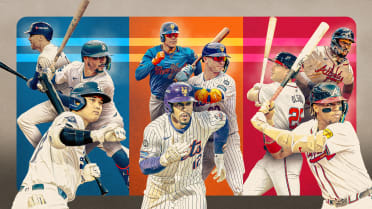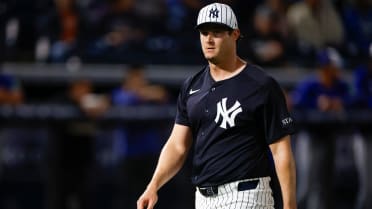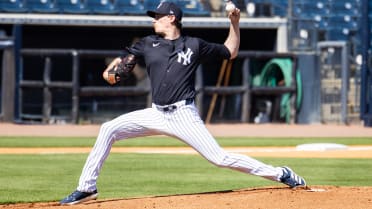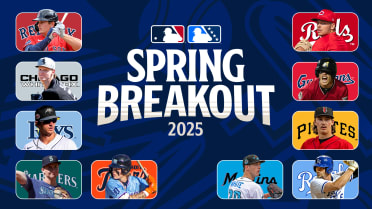Before he was a star, Betts almost a Brewer?
Mookie made strong impression during path to Majors
It was Dodgers president of baseball operations Andrew Friedman who ultimately convinced the Red Sox to part with Mookie Betts, the four-time All-Star and 2018 American League MVP Award winner. You know the details by now: On Feb. 10, the Dodgers acquired Betts and David Price for Alex Verdugo and prospects Connor Wong and Jeter Downs, then Los Angeles signed Betts to a 12-year extension.
But tip your cap to Doug Melvin, the Brewers’ longtime general manager, too. He tried to trade for Betts before anyone else.
Betts was only 20 years old at the time, a relatively unheralded prospect in the middle of a breakout 2013 season in Class A ball. The Red Sox were on their way to a World Series title, and Melvin was offering bullpen help in the form of Francisco Rodríguez.
“Doug Melvin was the first to ask, so I always give Doug credit,” said Ben Cherington, the Pirates’ general manager who held the same role in Boston from 2011-15. “He was the first one to ask for him.”
But Melvin wanted Betts in return. Cherington declined, and Milwaukee wound up flipping Rodríguez to Baltimore for Nicky Delmonico. By the end of the year, Betts was a bona fide prospect -- and rival executives never stopped asking for him.
“In every deal,” Cherington said. “Every deal, his name was the first one. It was a non-starter for us.”
Different people saw Betts’ potential for greatness at different points, long before he showed it all at once in Game 1 of the World Series. And by that point in 2013, the Red Sox understood they might have a star in the making.
***
Derek Johnson saw Betts’ potential earlier than most. To be fair, he got a head start. The longtime Vanderbilt University pitching coach, formerly of the Brewers and now with the Reds, has been watching Betts play since he was 12 years old growing up in Nashville, Tenn.
“One of the very first times I ever saw him play was in a summer game, and he was playing for a team called the Nashville Yankees,” Johnson said. “Since it was a Yankees uniform, or a Yankees-lookalike uniform, the first guy you think about is Derek Jeter. … [Mookie] was playing shortstop, and you’re watching this kid move. He’s young, but the way he’s moving at that age -- guys usually don’t move like that. You knew right away this guy was going to be special.”
But Betts, for all his talent and athleticism, was not necessarily a highly touted young player heading into or coming out of the 2011 Draft. Baseball America did not rank him among its top 200 prospects, and he wouldn’t even crack MLB Pipeline’s list of the top 20 Red Sox prospects until 2013.
Johnson could basically walk to watch Betts play for Overton High School, so he saw plenty of his games. He liked the way Betts moved and expected him to have a nice professional career. But a superstar? Back then, nobody saw that coming.
“I knew he was going to be good, but I had no idea he was going to be that good,” Johnson said. “I don’t know if you can ever think a kid is going to be as good as he is.”
***
Danny Watkins saw Betts’ potential as being greater than most. Covering the Southeast, the Red Sox area scout -- a “salt of the earth guy” who “has no problem doing a 14-hour round trip to watch a BP session,” Cherington said -- appreciated Betts’ athleticism as a baseball player, basketball player and even as a bowler.
“He’d been talking about him and was an advocate going into his senior year in high school and the summer before,” Cherington recalled. “Legitimately higher than a lot of the industry was on him at the time and believed in him.”
Leading up to the 2011 Draft, the Red Sox were using a service that tested players’ neurocognitive function. Essentially, it was designed to quantify a player’s vision, response time and hand-eye coordination. Betts’ results surpassed anyone’s expectations, signaling an elite ability to process information that would bode well for his pitch recognition and plate discipline, among other skills.
Boston’s innovative (at the time) use of sports science supported the scout’s conviction. Amiel Sawdaye, the Red Sox scouting director at the time, felt they could wait until the fifth round to pick Betts, but no later. They eventually signed him for $750,000, pulling him away from his commitment to attend the University of Tennessee.
“We had scouts with conviction. We had this interesting information about how he processed information based on this test,” Cherington said. “Loved that he seemed to excel across sports. Really good basketball player, really good bowler, just moved well when he was playing sports -- and a really likeable kid.”
***
As Boston’s general manager, Cherington saw Betts’ potential surge during his second season in the Red Sox system. In 2012, Betts proved to be a patient but powerless second baseman for Class A Lowell.
“He was just an interesting young player that we liked,” Cherington said, “but nobody would have honestly said at the time they were projecting him to be what he is now.”
Then Betts packed on some muscle and learned to drive the ball better, and he slashed .314/.417/.506 at two levels of Class A ball in 2013. His name started popping up on prospect lists and coming up in trade talks. In ‘14, he quickly learned to play the outfield and kept hitting throughout his leap to Double-A – and eventually Triple-A and the Majors.
“We were pretty confident at that point that like, ‘OK, we might have something that’s different here,’” Cherington said. “I could talk about Mookie all day, but if I could pinpoint one thing: He is about the best at practice that I’ve ever been around. And I don’t mean he spends more hours in the day -- although he probably spends a lot of hours in the day -- but he just gets so much out of his practice. Defense, baserunning, hitting.
“He’s got not just a purpose, but he has just this way. I would describe it as this almost humble approach to practice where he just goes into practice knowing he doesn’t have everything figured out, knowing there’s a way I can keep getting better today but also having enough confidence to do it.”
***
In the Brewers’ attempt to trade for Betts seven years ago, Melvin saw Betts’ potential as a trade candidate. At that point, the Red Sox system was headlined by hitters like Xander Bogaerts and Jackie Bradley Jr. and pitchers like Allen Webster, Henry Owens and Matt Barnes. Betts’ prospect rankings suggested he might be easier to pry away from Boston.
“We knew we weren’t going to get what was considered a top-level prospect, and Mookie sort of went under the radar if you went by the so-called MLB Pipeline or whatever,” Melvin said. “I don’t think at the time he was in their top 10-15 prospects. But I remember between our analytics department and Zack [Minasian’s] scouting department, I said, ‘Just give me some names.’”
Minasian worked as a Rangers clubhouse attendant as a kid (his dad ran the operation) and began his front office career as a Brewers intern at the very beginning of the club’s dive into analytics in the early 2000s. He rose to Brewers pro scouting director and now works in a similar capacity for the Giants.
“Mookie was one of the names that came up from the group,” Melvin said. “I always felt we worked well together, with both the analytics and scouting. I’d get names from both sides. And with Ben and the Red Sox, sometimes you call and ask for a top, top prospect and you almost [upset the other GM]. This wasn’t like that. Ben knew they had a good player, but it wasn’t like [Betts] was one of their top three prospects. We weren’t asking for Xander Bogaerts. It was more like, ‘Let’s go get a good A-ball player.’”
Melvin said he was flattered that Cherington remembers the conversation. These are Melvin’s favorite conversations -- the deals that were discussed but never made.
“That’s the stuff that I love thinking back on,” Melvin said. “I need to write this stuff down because as you get older, you forget it, the conversations you had. I’ve got notes on that, but Zack and Cory [Melvin, Doug’s son who is now a Yankees scout] are great at remembering all that stuff when I’d had conversations. The trades that almost happened.”
***
In the trade that did happen, Friedman saw Betts’ potential to dramatically upgrade a powerhouse team on and off the field -- as what he called “a really key, critical piece for us to add into the existing core that we had.” Looking to end a 32-year championship drought, the Dodgers sought legitimate, star-level production and someone who could positively impact their clubhouse culture.
They found it all in Betts.
“I remember talking to Andrew at some point after the trade and just remarking to him that he was really going to enjoy being around [Betts]. He’s fun to watch because he’s so good, but he’s also really easy to root for,” Cherington said. “I think everyone influences an environment in some way, but I don’t know that there’s too many people who really influence environments positively, sustainably and that consistently. And he does.”
Senior Reporter Adam Berry covers the Rays for MLB.com and covered the Pirates from 2015-21.
Supervising Club Reporter Adam McCalvy has covered the Brewers for MLB.com since 2001.




